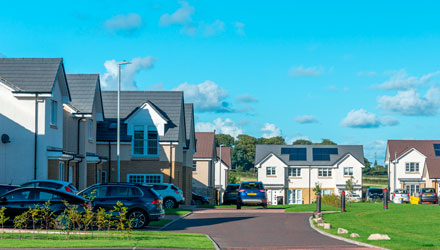By Sophie Neaves on Tue 21 November 2023
Scotland Leading The Way in Passivhaus Legislation

What is Passivhaus legislation?
A passive house is one that meets the Passive House Standard. These standards aim to keep a building’s effect on its surroundings to a minimum – hence ‘passive’.
The emphasis is on energy efficiency, using smart design and technology to retain heat, generate energy and also cool the building. This Passivhaus guide has more detailed information.
Passivhaus legislation sets out requirements for buildings to meet the Passivhaus standards – in an attempt to lower the environmental impact of our buildings.
How is Scotland leading the way in Passivhaus legislation?
In Scotland, Passivhaus legislation refers specifically to new-build housing. By stipulating that all new housing must meet Passivhaus-equivalent standards for minimum environmental design, Scotland has become a global leader in eco-conscious housing development.
Several regional and local authorities around the world have enacted Passivhaus laws, with many stipulating that new public buildings adhere to Passivhaus standards. Plus, many authorities offer financial support for new-build Passivhaus projects.
Passivhaus laws are particularly widespread in Germany, where the Passivhaus Institute is based. However, by requiring that all new-build homes meet Passivhaus-equivalent standards, Scotland has become only the second country in the world (after Luxembourg in 2017) to take the policy nationwide.
When did Scotland announce plans to enforce legislation?
The Scottish government announced its plans on 10 January 2023. In doing so, it committed to introducing new minimum environmental design standards which will represent a Scottish equivalent to the Passivhaus standard.
When are changes being rolled out in Scotland?
The new regulations will come into effect in December 2024, meaning that all homes built after then will have to meet the new standards.
Yet, Scotland is already making great strides in its passive house policy. For example, the country’s first Passivhaus social housing development was completed in December 2022.
How much is being invested in the project
The Passivhaus initiative is part of a larger multi-billion pound programme, which the Scottish government hopes will see it reach net zero carbon emissions by 2045. Before that, there’s an interim target of a 75% reduction in emissions by 2030 and a 90% reduction by 2040.
In contrast to Scotland’s Passivhaus commitment, there are less ambitious targets for England. In December 2021, the government announced new regulations that reduced the maximum carbon level for new homes by around a third.
Why is Passivhaus legislation so important in the United Kingdom?
The UK is aiming to make itself a world leader in renewable energy, which is one of the reasons behind its target of achieving net zero emissions by 2050.
The UK is also aiming to build 300,000 new homes each year. If all of these houses were passivhaus compliant, the energy savings would be considerable.
Research from the Passivhaus Trust found that even ‘zero-carbon’ houses (which go beyond new build standards) produce almost double the emissions of a Passivhaus home: around 18 kgCO22/m2 vs 11 kgCO2/m2 per year.
However, the UK’s housing stock is largely decades old, which means a low level of airtightness and, therefore, high energy costs. Insufficient insulation is another problem that leads to greater energy usage. As 2020 ended, 14.3 million UK properties had cavity wall insulation (70% of applicable properties), 16.6 million had loft insulation (66% of those with a loft) and 772,000 had solid wall insulation (just 9% of properties with solid walls).
If the UK wants to improve its carbon footprint, something needs to be done about updating its existing housing stock. Passivhaus legislation could be part of the solution.
Passivhaus and energy prices
It’s not just the government who will benefit from enacting Passivhaus legislation. If people find themselves moving into new Passivhaus properties, as they soon will in Scotland, their energy bills will be a fraction of what homeowners and tenants currently pay.
Of course, businesses would also benefit from such energy savings, particularly as they use significantly more energy than households. In tough economic times, businesses of all sizes would welcome lower energy bills.
The UK’s economic troubles were exacerbated when Russia invaded Ukraine, with the war leading to household gas prices rocketing from an average of £200 per year to £1,000.
But for Passivhaus properties that require less energy, the impact of energy cost hikes like this is much less severe. And the fewer energy-thirsty properties we have in the UK in general, the more insulated the country will be from such energy market developments.
Passivhaus and health
Cardiovascular diseases are the UK’s second biggest killer. Exposure to air pollutants and low air quality can cause higher blood pressure and other heart issues with serious repercussions to health. However, the continuous ventilation required by Passivhaus standards significantly improves air quality and as a result, Passivhaus legislation can actively save lives.
Beyond that, it would also improve everyday health for millions of people. By improving air quality, Passivhaus ventilation systems like MVHR help to reduce the likelihood of respiratory conditions like asthma and bronchitis taking hold or getting worse. Virus transmission is also less likely when a building’s air is regularly refreshed.
In addition, poor air quality leads to lower levels of concentration and higher levels of fatigue. This has repercussions for schools, universities and businesses, in particular.
When is the rest of the UK expected to follow?
Committing to widespread adoption of Passivhaus standards is undoubtedly a worthwhile aim, for any nation.
However, it cannot be disregarded that it will be significantly easier – and less costly – for Scotland to embrace Passivhaus on a nationwide scale than it would be for England. Scotland’s neighbour to the south has a population 10 times its size.
In addition, factors such as Brexit and the Covid-19 pandemic have cost the UK dearly, meaning government investment in Passivhaus might not be forthcoming anytime soon.